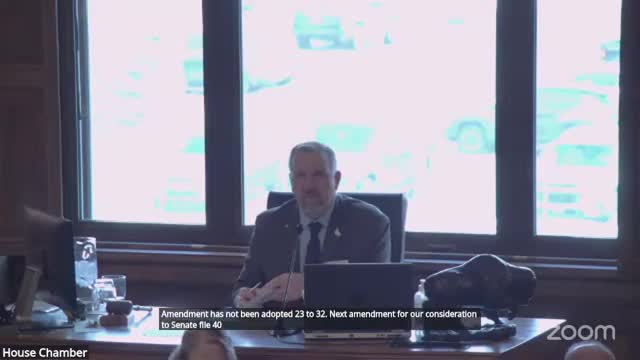House floor debate on abandoned‑building incentives and tax‑increment financing ends with failed amendments
This article was created by AI summarizing key points discussed. AI makes mistakes, so for full details and context, please refer to the video of the full meeting. Please report any errors so we can fix them. Report an error »

Lawmakers debated two substantive floor amendments on Senate File 40 — a proposal to create property‑tax credits for owners who demolish or rehabilitate abandoned buildings and a separate amendment to expand tax‑increment financing (TIF) for housing. Both amendments failed on the House floor Feb. 14; the bill was then ordered to third reading.
Representative Sherwood moved the first amendment, describing a program that would allow municipalities to designate certain buildings as abandoned or nuisance, cap the number of designated properties by community size, and offer a documented, expense‑based property tax credit (for demolition or bringing a building up to code). "I will move second reading amendment number 1 to senate file 40 and ask you for your favorable consideration," Sherwood said while outlining the incentive structure.
Supporters said the amendment would give cities tools to address unsafe, vacant properties without forcing local governments to shoulder demolition costs alone. Representative Thayer said it would provide local tools to address safety and property‑value impacts; Representative Gehringer described it as a practical solution for workforce housing barriers. Opponents raised fiscal and policy concerns: Representative Bair said the amendment could circumvent measures agreed the prior day and urged resistance; Representative Aleman said localities should craft their own rules. After a division vote the chair announced the amendment had not been adopted (23‑32).
Representative Yen offered a second amendment to allow TIF to be used specifically for housing development. Yen argued the change would make tax‑increment financing a practical tool for workforce housing in places that need it. Supporters, including Representative Gehringer and Representative Wiley, framed TIF as a financing tool that uses future incremental tax revenue to repay infrastructure costs needed to make a project feasible. Critics warned of historical abuses: Representative Kelly said TIF expansions have in other states led to gentrification and favored well‑connected developers; Representative Harshman and others cautioned about unintended long‑term burdens. Yen called for the ayes and noes; the roll call read 22 aye, 37 no, 3 excused, and the amendment failed.
Discussion vs. decision: the House debated policy design (incentives vs. restraint), local control, and housing finance mechanics, but rejected both proposed changes. The transcript includes substantive summaries of how the TIF mechanism operates, proponents’ examples of how incremental tax revenue pays infrastructure costs, and repeated admonitions from opponents about historical outcomes.
Actions recorded: first floor amendment not adopted (23‑32); second amendment (TIF expansion) defeated on roll call (22‑37‑3 excused). The bill proceeds to third reading with neither floor amendment added.
Representative Sherwood moved the first amendment, describing a program that would allow municipalities to designate certain buildings as abandoned or nuisance, cap the number of designated properties by community size, and offer a documented, expense‑based property tax credit (for demolition or bringing a building up to code). "I will move second reading amendment number 1 to senate file 40 and ask you for your favorable consideration," Sherwood said while outlining the incentive structure.
Supporters said the amendment would give cities tools to address unsafe, vacant properties without forcing local governments to shoulder demolition costs alone. Representative Thayer said it would provide local tools to address safety and property‑value impacts; Representative Gehringer described it as a practical solution for workforce housing barriers. Opponents raised fiscal and policy concerns: Representative Bair said the amendment could circumvent measures agreed the prior day and urged resistance; Representative Aleman said localities should craft their own rules. After a division vote the chair announced the amendment had not been adopted (23‑32).
Representative Yen offered a second amendment to allow TIF to be used specifically for housing development. Yen argued the change would make tax‑increment financing a practical tool for workforce housing in places that need it. Supporters, including Representative Gehringer and Representative Wiley, framed TIF as a financing tool that uses future incremental tax revenue to repay infrastructure costs needed to make a project feasible. Critics warned of historical abuses: Representative Kelly said TIF expansions have in other states led to gentrification and favored well‑connected developers; Representative Harshman and others cautioned about unintended long‑term burdens. Yen called for the ayes and noes; the roll call read 22 aye, 37 no, 3 excused, and the amendment failed.
Discussion vs. decision: the House debated policy design (incentives vs. restraint), local control, and housing finance mechanics, but rejected both proposed changes. The transcript includes substantive summaries of how the TIF mechanism operates, proponents’ examples of how incremental tax revenue pays infrastructure costs, and repeated admonitions from opponents about historical outcomes.
Actions recorded: first floor amendment not adopted (23‑32); second amendment (TIF expansion) defeated on roll call (22‑37‑3 excused). The bill proceeds to third reading with neither floor amendment added.
View full meeting
This article is based on a recent meeting—watch the full video and explore the complete transcript for deeper insights into the discussion.
View full meeting